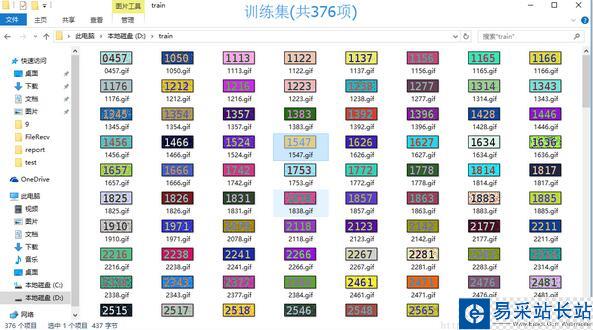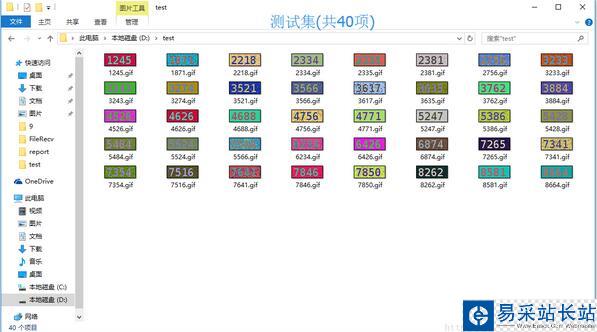简单的Tensorflow验证码识别应用,供大家参考,具体内容如下
1.Tensorflow的安装方式简单,在此就不赘述了.
2.训练集训练集以及测试及如下(纯手工打造,所以数量不多):


3.实现代码部分(参考了网上的一些实现来完成的)
main.py(主要的神经网络代码)
from gen_check_code import gen_captcha_text_and_image_new,gen_captcha_text_and_imagefrom gen_check_code import numberfrom test_check_code import get_test_captcha_text_and_imageimport numpy as npimport tensorflow as tftext, image = gen_captcha_text_and_image_new()print("验证码图像channel:", image.shape) # (60, 160, 3) # 图像大小 IMAGE_HEIGHT = image.shape[0]IMAGE_WIDTH = image.shape[1]image_shape = image.shapeMAX_CAPTCHA = len(text)print("验证码文本最长字符数", MAX_CAPTCHA) # 验证码最长4字符; 我全部固定为4,可以不固定. 如果验证码长度小于4,用'_'补齐# 把彩色图像转为灰度图像(色彩对识别验证码没有什么用)# 度化是将三分量转化成一样数值的过程def convert2gray(img): if len(img.shape) > 2: gray = np.mean(img, -1) # 上面的转法较快,正规转法如下 # r, g, b = img[:,:,0], img[:,:,1], img[:,:,2] # gray = 0.2989 * r + 0.5870 * g + 0.1140 * b # int gray = (int) (0.3 * r + 0.59 * g + 0.11 * b); return gray else: return img""" cnn在图像大小是2的倍数时性能最高, 如果你用的图像大小不是2的倍数,可以在图像边缘补无用像素。 np.pad(image,((2,3),(2,2)), 'constant', constant_values=(255,)) # 在图像上补2行,下补3行,左补2行,右补2行 """char_set = number # 如果验证码长度小于4, '_'用来补齐CHAR_SET_LEN = len(char_set)# 文本转向量def text2vec(text): text_len = len(text) if text_len > MAX_CAPTCHA: raise ValueError('验证码最长4个字符') vector = np.zeros(MAX_CAPTCHA * CHAR_SET_LEN) def char2pos(c): try: k = ord(c)-ord('0') except: raise ValueError('No Map') return k for i, c in enumerate(text): idx = i * CHAR_SET_LEN + char2pos(c) vector[idx] = 1 return vector# 向量转回文本def vec2text(vec): char_pos = vec.nonzero()[0] text = [] for i, c in enumerate(char_pos): char_at_pos = i # c/63 char_idx = c % CHAR_SET_LEN if char_idx < 10: char_code = char_idx + ord('0') elif char_idx < 36: char_code = char_idx - 10 + ord('A') elif char_idx < 62: char_code = char_idx - 36 + ord('a') elif char_idx == 62: char_code = ord('_') else: raise ValueError('error') text.append(chr(char_code)) return "".join(text)# 生成一个训练batchdef get_next_batch(batch_size=128): batch_x = np.zeros([batch_size, IMAGE_HEIGHT * IMAGE_WIDTH]) batch_y = np.zeros([batch_size, MAX_CAPTCHA * CHAR_SET_LEN]) # 有时生成图像大小不是(60, 160, 3) def wrap_gen_captcha_text_and_image(): while True: text, image = gen_captcha_text_and_image_new() if image.shape == image_shape: return text, image for i in range(batch_size): text, image = wrap_gen_captcha_text_and_image() image = convert2gray(image) batch_x[i, :] = image.flatten() / 255 # (image.flatten()-128)/128 mean为0 batch_y[i, :] = text2vec(text) return batch_x, batch_y####################################################################X = tf.placeholder(tf.float32, [None, IMAGE_HEIGHT * IMAGE_WIDTH])Y = tf.placeholder(tf.float32, [None, MAX_CAPTCHA * CHAR_SET_LEN])keep_prob = tf.placeholder(tf.float32) # dropout# 定义CNNdef crack_captcha_cnn(w_alpha=0.01, b_alpha=0.1): x = tf.reshape(X, shape=[-1, IMAGE_HEIGHT, IMAGE_WIDTH, 1]) # w_c1_alpha = np.sqrt(2.0/(IMAGE_HEIGHT*IMAGE_WIDTH)) # # w_c2_alpha = np.sqrt(2.0/(3*3*32)) # w_c3_alpha = np.sqrt(2.0/(3*3*64)) # w_d1_alpha = np.sqrt(2.0/(8*32*64)) # out_alpha = np.sqrt(2.0/1024) # 定义三层的卷积神经网络 # 定义第一层的卷积神经网络 # 定义第一层权重 w_c1 = tf.Variable(w_alpha * tf.random_normal([3, 3, 1, 32])) # 定义第一层的偏置 b_c1 = tf.Variable(b_alpha * tf.random_normal([32])) # 定义第一层的激励函数 conv1 = tf.nn.relu(tf.nn.bias_add(tf.nn.conv2d(x, w_c1, strides=[1, 1, 1, 1], padding='SAME'), b_c1)) # conv1 为输入 ksize 表示使用2*2池化,即将2*2的色块转化成1*1的色块 conv1 = tf.nn.max_pool(conv1, ksize=[1, 2, 2, 1], strides=[1, 2, 2, 1], padding='SAME') # dropout防止过拟合。 conv1 = tf.nn.dropout(conv1, keep_prob) # 定义第二层的卷积神经网络 w_c2 = tf.Variable(w_alpha * tf.random_normal([3, 3, 32, 64])) b_c2 = tf.Variable(b_alpha * tf.random_normal([64])) conv2 = tf.nn.relu(tf.nn.bias_add(tf.nn.conv2d(conv1, w_c2, strides=[1, 1, 1, 1], padding='SAME'), b_c2)) conv2 = tf.nn.max_pool(conv2, ksize=[1, 2, 2, 1], strides=[1, 2, 2, 1], padding='SAME') conv2 = tf.nn.dropout(conv2, keep_prob) # 定义第三层的卷积神经网络 w_c3 = tf.Variable(w_alpha * tf.random_normal([3, 3, 64, 64])) b_c3 = tf.Variable(b_alpha * tf.random_normal([64])) conv3 = tf.nn.relu(tf.nn.bias_add(tf.nn.conv2d(conv2, w_c3, strides=[1, 1, 1, 1], padding='SAME'), b_c3)) conv3 = tf.nn.max_pool(conv3, ksize=[1, 2, 2, 1], strides=[1, 2, 2, 1], padding='SAME') conv3 = tf.nn.dropout(conv3, keep_prob) # Fully connected layer # 随机生成权重 w_d = tf.Variable(w_alpha * tf.random_normal([1536, 1024])) # 随机生成偏置 b_d = tf.Variable(b_alpha * tf.random_normal([1024])) dense = tf.reshape(conv3, [-1, w_d.get_shape().as_list()[0]]) dense = tf.nn.relu(tf.add(tf.matmul(dense, w_d), b_d)) dense = tf.nn.dropout(dense, keep_prob) w_out = tf.Variable(w_alpha * tf.random_normal([1024, MAX_CAPTCHA * CHAR_SET_LEN])) b_out = tf.Variable(b_alpha * tf.random_normal([MAX_CAPTCHA * CHAR_SET_LEN])) out = tf.add(tf.matmul(dense, w_out), b_out) # out = tf.nn.softmax(out) return out# 训练def train_crack_captcha_cnn(): # X = tf.placeholder(tf.float32, [None, IMAGE_HEIGHT * IMAGE_WIDTH]) # Y = tf.placeholder(tf.float32, [None, MAX_CAPTCHA * CHAR_SET_LEN]) # keep_prob = tf.placeholder(tf.float32) # dropout output = crack_captcha_cnn() # loss # loss = tf.reduce_mean(tf.nn.softmax_cross_entropy_with_logits(output, Y)) loss = tf.reduce_mean(tf.nn.sigmoid_cross_entropy_with_logits(output, Y)) # 最后一层用来分类的softmax和sigmoid有什么不同? # optimizer 为了加快训练 learning_rate应该开始大,然后慢慢衰 optimizer = tf.train.AdamOptimizer(learning_rate=0.001).minimize(loss) predict = tf.reshape(output, [-1, MAX_CAPTCHA, CHAR_SET_LEN]) max_idx_p = tf.argmax(predict, 2) max_idx_l = tf.argmax(tf.reshape(Y, [-1, MAX_CAPTCHA, CHAR_SET_LEN]), 2) correct_pred = tf.equal(max_idx_p, max_idx_l) accuracy = tf.reduce_mean(tf.cast(correct_pred, tf.float32)) saver = tf.train.Saver() with tf.Session() as sess: sess.run(tf.global_variables_initializer()) step = 0 while True: batch_x, batch_y = get_next_batch(64) _, loss_ = sess.run([optimizer, loss], feed_dict={X: batch_x, Y: batch_y, keep_prob: 0.75}) print(step, loss_) # 每100 step计算一次准确率 if step % 100 == 0: batch_x_test, batch_y_test = get_next_batch(100) acc = sess.run(accuracy, feed_dict={X: batch_x_test, Y: batch_y_test, keep_prob: 1.}) print(step, acc) # 如果准确率大于50%,保存模型,完成训练 if acc > 0.99: saver.save(sess, "./crack_capcha.model", global_step=step) break step += 1## 训练(如果要训练则去掉下面一行的注释)train_crack_captcha_cnn()def crack_captcha(): output = crack_captcha_cnn() saver = tf.train.Saver() with tf.Session() as sess: saver.restore(sess, tf.train.latest_checkpoint('.')) predict = tf.argmax(tf.reshape(output, [-1, MAX_CAPTCHA, CHAR_SET_LEN]), 2) count = 0 # 因为测试集共40个...写的很草率 for i in range(40): text, image = get_test_captcha_text_and_image(i) image = convert2gray(image) captcha_image = image.flatten() / 255 text_list = sess.run(predict, feed_dict={X: [captcha_image], keep_prob: 1}) predict_text = text_list[0].tolist() predict_text = str(predict_text) predict_text = predict_text.replace("[", "").replace("]", "").replace(",", "").replace(" ","") if text == predict_text: count += 1 check_result = ",预测结果正确" else: check_result = ",预测结果不正确" print("正确: {} 预测: {}".format(text, predict_text) + check_result) print("正确率:" + str(count) + "/40")# 测试(如果要测试则去掉下面一行的注释)# crack_captcha()
新闻热点
疑难解答